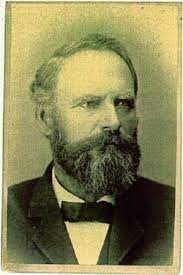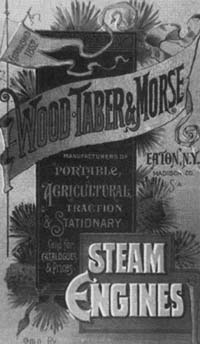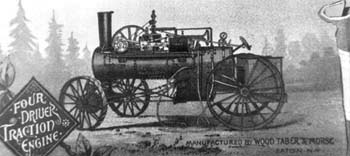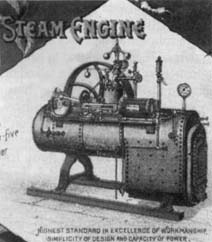Wood, Taber & Morse Co.

Clark Taber
The Toronto Globe, August 25, 1885:
'The four-driver steam engine of Wood, Taber and Morse was exhibited at the annual Industrial Exposition of Canada in Toronto and was well accepted by people of the Dominion, 45,000 of whom were on the grounds Wednesday. The machine also was exhibited at the Provincial Show at London, where it was awarded the Gold Medal. Although the four-driver has been on the market only a month, 19 orders have been received at the factory.'
It is famed for making a four-wheel drive engine, that was quite successful. Only one engine survives to this day, and it is in the Henry Ford Museum
Size B 6 HP S. W. Wood & Son portable steam engine
They're still out there
Steve Davis
January/February 2004

Size B 6 HP S_ W_ Wood & Son portable steam engine
Head-on view of the Size B 6 HP S.W. Wood & Son portable steam engine. In addition to a line of steam traction engines, S.W. Wood & Son, Clyde, N.Y., built Size B 6 HP and Size C 8 HP portables.
In July 2003, Hesse Galleries of Otego, N.Y., auctioned off a small portable steam engine made by S.W. Wood & Son of Clyde, N.Y. It is a Size B, 6 HP, 5-inch-by-8-inch bore and stroke. It is very small, having a boiler shell of only 22 inches. This is a really cute-sized engine small enough that it would fit in the back of a pickup truck.
On auction day the steam fraternity was out in force, with many of us congregating in the rear of the auction room. As the auction drew near, the usual questions arose: 'How much do you think it will bring?' 'How much are you willing to bid?' 'The state will never inspect it, you know.'
The engine was in remarkable condition, even retaining a lot of its original paint, which is most unusual. The assembled steam fans were perplexed as to how this engine could have been in the area all these years, and yet not one of us had ever heard of it. It turns out it had been placed in a garage in Colliersville, N.Y., in 1938, not seeing the light of day again until this past July. One local collector who has been involved in the hobby over 40 years lived only 2 miles away, never dreaming of its existence.
Jackie Hesse of Hesse Galleries says the engine was used as a power unit by the Westville Cheese factory in Westford, N.Y., and spent its operating life there. The late owner of the engine worked for the cheese company and acquired the engine (along with the barn it was housed in) when the engine was retired.
As the bidding heated up, our dreams started to evaporate, and not one of the local collectors ever had a chance to buy the engine. Rumor has it that the successful phone bidder bought the engine for a museum with sufficient funds to have a new boiler built, which is the only way the engine could ever be operated here in New York, as the original boiler lacked papers and was a single-unit lap seam.
We hope the new owner will keep us informed of the engine's future through SteamTraction.com.
S.W. Wood Engine Co.
A Surviving 16 HP Wood Steam Traction Engine
By Steve Davis - June 2007

16 HP New Model Wood Steam Engine

Steve Davisí 1914 16 HP New Model Wood steam traction engine.
This is the short life story of "Oatie," a surviving engine built by, S.W. Wood Engine Co., in upstate New York. The Wood company, located in Clyde, N.Y., in Wayne County, was organized in 1831 and made various products under a succession of owners. Seth Wood took control of the company in 1866. Two years later the first of the portable steamers was built. Traction engines steered by horse were added in 1881, and by 1882, self-steering traction engines were produced.
Prayer Of The Old Engineers
Old Engineers As they talked about steam, and the Steam Engine years...
During this period the Wood company did not produce any related products such as threshers and sawmills, as did most steam engine firms. The company concentrated their efforts on steam alone. After 1926, the company focused on repair and machine work, and operated under various owners throughout the years until closing in 1954. The firm operated under the names S.W. Wood, S.W. Wood & Son and S.W. Wood Engine Co. Today, none of the factory buildings remain.
In 1914 the firm produced a 16 HP New Model traction engine, which differed from previous engines. One of the New Models was purchased by Otis Deyoe (hence the nickname "Oatie"), an agent for the Wood company, of Prattsville, Green County, N.Y., for $1,900. Prattsville is located in the rugged Catskill Mountains of eastern New York. It was delivered in nearby Grand Gorge, N.Y. Years ago I had the pleasure of talking with a gentleman who, as a child, had been allowed to stay home from school the day the engine was delivered.
The New Model joined a skid engine and an older model 12 HP traction engine of the same make. Soon after delivery, a heavy snowfall collapsed many local buildings creating a large demand for lumber. The New Model engine was put to work on a sawmill until demand was met. I have been told this was about the only serious work, for any duration, the engine ever performed.
In the 1920s, Otis had some family problems and activity on the home slowed down. In his later years he became somewhat of a hermit. His infrequent trips to town were made on a homemade tractor. In 1955 Otis died in a tragic fire in his farmhouse. Today, no traces remain of any of the buildings that once stood on the site.
An auction was held to dispose of all the items remaining on the property. The auction was attended by a local scrap dealer and his friend Carl Wilkinson. The scrap dealer bought all his pocket-book would allow and borrowed money from Carl to continue bidding. A short time later, the scrap man had junked the skid engine and the older traction engine, and came to repay the borrowed funds. Carl considered forgiving the loan in return for the remaining traction engine. A deal was struck and Oatie escaped the torch.
Carl was a little disappointed when he went to retrieve the engine, as many major and minor items were missing. Somehow, he loaded the engine on his 1-1/2-ton Chevrolet truck. The engine was longer than the rack so he laid down heavy timbers to support the engine's front wheels beyond the end of the truck bed. Then Carl crawled down the mountains, mostly in first gear, fearing the worst most of the way. (I am familiar with this area of the mountains and the ride must have been truly terrifying.)

Prayer Of The Old Engineers
Old Engineers As they talked about steam, and the Steam Engine years...
Carl thought the engine would be a drawing card at his farm equipment business about 20 miles east in Coxsackie, N.Y. His plans to paint the engine and place it out front of the business never materialized. The engine sat in the horse pasture until 1969. This is the only time, of any extent, the engine sat in the weather since it was new, but it had been saved.
This is when I entered the picture, armed with funds I received from the sale of my Birdsall traction engine (another story in itself). I bought the engine and had it trucked home, and not on a ton and a half either! Then I began the repairs, replacement and restoration process. Surely many readers with old engine affliction can relate.
In June of 1976, armed with a new state boiler certificate, Oatie ran again. How many years had elapsed since it was last run is anyone's guess, but surely a long, long time. When the engine had been last used all the hand holes had been removed, which kept air circulating. Coupled with being under cover many years, this preserved the boiler very well. To this day, the stay bolts exhibit sharp threads right to the crown sheet, an area where much wasting sometimes occurs.
Oatie has threshed and run a sawmill at home, and appeared at the New York Steam Engine Assn.'s Pageant of Steam in Canandaigua, N.Y., a few times. I believe I am the only one to own and operate Oatie - other than the original owner - since it left Clyde on a flatcar 93 years ago.
I have attempted to locate or document other surviving S.W. Wood engines and discovered 18 of them thus far. Sixteen are small portables, about half of them operational. A 12 HP traction engine survives, the only known, but unfortunately sidelined with serious boiler problems. As it stands, Oatie is the only known 16 HP.
Eaton's famous Wood, Taber & Morse Steam Engine Works
Mary Messere
Syracuse Historic Places Examiner
Early advertisement for Eaton's famous Wood, Taber & Morse Steam Engine Works.

Old Town of Eaton Museum
Steam as a means of power came into the forefront in the mid-eighteen hundreds in young America. An innovative new means of portable power became the idea behind steam engine development. The swift flowing streams and rivers that ran most of the early industries were the reasons for much of the early settlement in central New York.
One such company, A N Wood Company, in 1848 became only the fourth producer of steam engines in America. The company that located in Eaton Village became an overnight success that brought prosperity and jobs to an area that was once a boomtown because of the swift flowing Eaton Brook. Its founders Allen N. Wood and his uncle Enos Wood expanded to Utica also founding Mann & Wood Steam Engine Works.
Allen moved back to Eaton and acquired two partners, Loyal Clark Tabor a brilliant engineer, and Walter Morse of the famous Morse family of Eaton as the business manager. These men became the Wood, Taber & Morse Steam Engine Company, a company that would eventually have three offices one in Augusta, Georgia, Chicago, Illinois, and Eaton, New York.
By 1884 the company had designed the first practical four-wheel drive steam engine capable of pulling machinery and man into the fields. The company won the "Blue Ribbon of Excellence" at the 1886 World's Fair in London, England for its design plus many other prestigious awards. The four-wheel drive mechanical drive transmission became the fore-runner of today's modern four wheel drive transmissions and many unique features used in its design we use today including the development of the universal joint. Henry Ford seeing the machine in his neighbor's field actually bought it to show in his museum where it is preserved today.

Other early models were used to pump oil in the Pennsylvania oil fields, to run cotton gins and cloth weaving machinery in the south and its portable engine pulled by a team of horse made its mark in the opening of the west to agriculture.
Today, Eaton has become a sleepy hamlet in Madison County, New York with only a historic marker denoting its once famous past. A past that actually put it self out of business, as the water that flowed in the southern part of the county to run industry were no longer needed. Now mills and manufacturing could be located near better transportation routes, run by the steam engines that its famous engine company produced.







